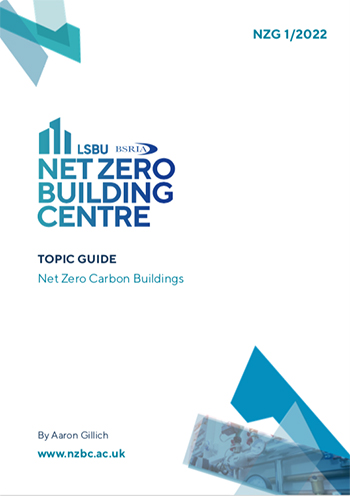The LSBU and BSRIA Net zero building centre, topic guide Net Zero Carbon Buildings
The LSBU and BSRIA Net zero building centre, topic guide Net Zero Carbon Buildings
This guide, designed for facilities managers, building owners, building occupiers, building services professionals and product manufacturers, is a succinct document with some specific details on the theme. Starting with what net zero is, where it stemmed from, the related legislation, (in particular the UK’s net zero strategy) and the significant role the built environment plays in the mix, as well the impact of 'business as usual'.
The document goes on to explain embodied carbon and operational carbon, along with simple comparative charts for office, residential and school buildings from regulation standards to ultra low-energy building levels. It goes further to describe how these balance and look when spread across a buildings' life-span, explaining the concept and necessity of considering whole life carbon.
The document touches on details about designing and building to net zero, describing the hierarchy of approach to impact measures, from the greatest impact potential of the fabric (the so called fabric first approach), to onsite renewables and carbon off-sets. It highlights the stark realities in the performance of the current building stock, where average existing homes might have space heating demands of approximately 130 kWh/m2.year, wheras typical new build homes consume 85 kWh/m2.per year, and lower standards that display fabric first principles such as Passivhaus or LETI, consume just 15 kWh/m2.year. The report does not forget to mention the added benefits of action that run beyond carbon such as reducing system sizing and cost, comfort improvement as well as health benefits, along with operating costs, diminishing fuel poverty and reducing demand for new energy infrastructure.
The report highlights operations through tools such as, BREEAM, LEED, the Well Building Standard as well as NABERS and how frameworks such as BSRIA’s Soft Landings can assist in the flow of information needed by stakeholders to maintain performance over longer time periods. This moves the document neatly onto systems used in net zero buildings, and the role of solutions such a heat pumps, heat networks, and direct electric heating, along with hybrid combination systems or biofuels as part of net zero infrastructure systems. Finally describing the future of the energy mix, including gas and hydrogen, with useful infographics on production, market, transmission, distribution, and consumer issues, showing how mixes are likely to change between now and 2050.
Finally in summing up, the document describes the drivers for change and legislation. It praises the current goals that have been set but highlights the lack of actionable policies, despite 75% of local authorities now declaring climate emergencies. The document very clearly and definitively aligns this with carbon budgets and the relative ease with which historical carbon budgets were met through the phasing out of coal, noting that savings in future budgets as we now enter the 6th budget, will become increasing difficult.
Article written by editor based on a review of the BSRIA publication "Net Zero Carbon Buildings (NZG 1/2022)" written by Aaron Gillich and available for free download via the weblink above.
[edit] Related articles on Designing Buildings
- Actuate UK issues climate warning and urges action.
- A zero-carbon UK by 2050?
- Carbon negative.
- Carbon neutral.
- Climate Change Act.
- CO2nstruct Zero programme grows to over 70 businesses.
- Fabric first investigation into net zero for existing buildings.
- Nearly zero-energy building.
- Net Zero All Party Parliamentary Group NZ APPG.
- Net zero by 2050.
- Net zero (whole life) carbon.
- Smoothing the path to net zero.
- Transform to Net Zero.
Featured articles and news
RTPI leader to become new CIOB Chief Executive Officer
Dr Victoria Hills MRTPI, FICE to take over after Caroline Gumble’s departure.
Social and affordable housing, a long term plan for delivery
The “Delivering a Decade of Renewal for Social and Affordable Housing” strategy sets out future path.
A change to adoptive architecture
Effects of global weather warming on architectural detailing, material choice and human interaction.
The proposed publicly owned and backed subsidiary of Homes England, to facilitate new homes.
How big is the problem and what can we do to mitigate the effects?
Overheating guidance and tools for building designers
A number of cool guides to help with the heat.
The UK's Modern Industrial Strategy: A 10 year plan
Previous consultation criticism, current key elements and general support with some persisting reservations.
Building Safety Regulator reforms
New roles, new staff and a new fast track service pave the way for a single construction regulator.
Architectural Technologist CPDs and Communications
CIAT CPD… and how you can do it!
Cooling centres and cool spaces
Managing extreme heat in cities by directing the public to places for heat stress relief and water sources.
Winter gardens: A brief history and warm variations
Extending the season with glass in different forms and terms.
Restoring Great Yarmouth's Winter Gardens
Transforming one of the least sustainable constructions imaginable.
Construction Skills Mission Board launch sector drive
Newly formed government and industry collaboration set strategy for recruiting an additional 100,000 construction workers a year.
New Architects Code comes into effect in September 2025
ARB Architects Code of Conduct and Practice available with ongoing consultation regarding guidance.
Welsh Skills Body (Medr) launches ambitious plan
The new skills body brings together funding and regulation of tertiary education and research for the devolved nation.
Paul Gandy FCIOB announced as next CIOB President
Former Tilbury Douglas CEO takes helm.
UK Infrastructure: A 10 Year Strategy. In brief with reactions
With the National Infrastructure and Service Transformation Authority (NISTA).
























Comments
[edit] To make a comment about this article, click 'Add a comment' above. Separate your comments from any existing comments by inserting a horizontal line.